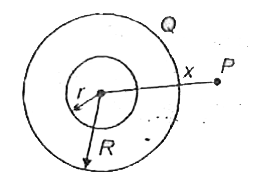Two hollow conducting spheres of radii R1 and R2 (R1⟩R2) have equal charges. The potential would be:
more on bigger sphere
more on smaller sphere
equal on both the spheres
dependent on the material property of the sphere
To solve the problem of determining the potential of two hollow conducting spheres with radii R1 and R2 (where R1>>R2) that have equal charges, we can follow these steps:
1. Understanding the Concept of Electric Potential:
- The electric potential V at the surface of a charged conductor is given by the formula:
V=K⋅QR
where K is a constant (Coulomb's constant), Q is the charge, and R is the radius of the sphere.
2. Identifying the Charges and Radii:
- Let both spheres have the same charge Q.
- The first sphere has a radius R1 and the second sphere has a radius R2.
3. Calculating the Potential for Each Sphere:
- For the larger sphere (radius R1):
V1=K⋅QR1
- For the smaller sphere (radius R2):
V2=K⋅QR2
4. Comparing the Potentials:
- Since R1>>R2, it follows that R1 is much larger than R2.
- Therefore, the potential V1 will be less than V2 because the potential is inversely proportional to the radius:
V1<V2
5. Conclusion:
- The potential on the smaller sphere (radius R2) is greater than that on the larger sphere (radius R1):
V2>V1
Final Answer:
The potential would be greater on the smaller sphere V2>V1.
- The electric potential V at the surface of a charged conductor is given by the formula:
V=K⋅QR
where K is a constant (Coulomb's constant), Q is the charge, and R is the radius of the sphere.
- Let both spheres have the same charge Q.
- The first sphere has a radius R1 and the second sphere has a radius R2.
- For the larger sphere (radius R1):
V1=K⋅QR1
- For the smaller sphere (radius R2):
V2=K⋅QR2
- Since R1>>R2, it follows that R1 is much larger than R2.
- Therefore, the potential V1 will be less than V2 because the potential is inversely proportional to the radius:
V1<V2
- The potential on the smaller sphere (radius R2) is greater than that on the larger sphere (radius R1):
V2>V1
The potential would be greater on the smaller sphere V2>V1.
Topper's Solved these Questions
Similar Questions
Consider two conducting spheres of radii R1andR2 with R1>R2. If the two are at the same potential, the larger sphere has more charge than the smaller sphere. State whetehr the charge density of the smaller sphere is more or less than that of the larger oe.
View SolutionConsider two conducting spheres of radii R1andR2 with R1>R2. If the two are at same potential, the larger sphere has more charge than the smaller sphere, then charge density of the smaller sphere is more than that of the larger one.
View Solution
Knowledge Check
- Question 1 - Select One
Two conducting spheres of radii r1 and r2 are equally charged. The ratio of their potentral is-
Ar21/r22Br22/r21Cr1/r2Dr2/r1 - Question 2 - Select One
Consider two conductinbg spheres of radill R1andR2 with R1>R2. If the two are at the same potential, and the larger sphere has more charge than the smaller sphere, then
Athe charge density of smaller sphere is less then that of larger sphere,Bthe charge density of smaller sphere is more than that of larger sphere.Cboth spheres may have same charge density.Dnone of these - Question 3 - Select One
Two charged spheres of radii R1andR2 having equal surface charge density. The ratio of their potential is
AR1/R2BR2/R1C(R1/R2)2D(R2/R1)2
A charge Q has been divided on two concentirc conducting spheres of radii R1andR2(R1>R2) such that the surface charge
densities on both the sphere is same.
Find the potential at their common center.View SolutionConsider two conducting spheres of radii R1andR2 with R1>R2. If the two are at the same potential, the larger sphere has more charge than the smaller sphere. State whetehr the charge density of the smaller sphere is more or less than that of the larger oe.
View SolutionTwo conducting spheres of radii r1 and r2 are charged to the same surface charge density . The ratio of electric field near their surface is
View SolutionA charge Q has been divided on two concentric conducting spheres of radii R1 and R2(R1>R1) such that the surface charge densities on both the spheres are equal. The potential at their common centre is
View SolutionTwo concentric hollow conducting spheres of radius r and R are shown. The charge on outer shell is Q. what charge should be given to inner sphere so that the potential at any point P outside the outer sphere is zero ?
 View Solution
View Solution

